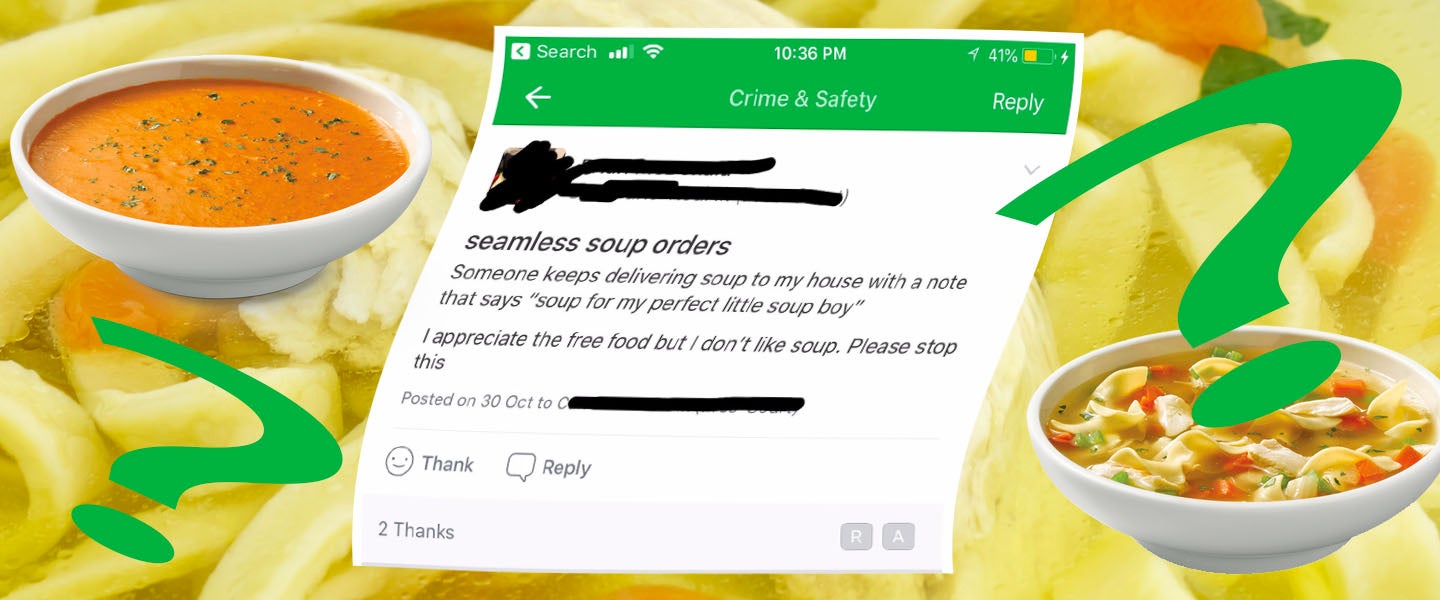Like the tens of thousands of other people who saw it, I was greatly amused and baffled by a viral screenshot from Nextdoor, a social network organized around local communities. First shared by actor and comedian Hannah Solow on Twitter, the image soon made its way to Reddit and then a number of media outlets. Posted in the “Crime & Safety” section of a New York neighborhood’s private forum, it lodged a complaint regarding unwanted food delivery orders. “Someone keeps delivering soup to my house with a note that says ‘soup for my perfect little soup boy.’” The author couldn’t explain it.
Someone posted this to our neighborhood message board and I will never recover. pic.twitter.com/1uWwOKHHsZ
— Hannah Solow (@hamstertalk) November 8, 2018
The mystery kicked off a fierce debate on the intrinsic goodness or badness of soup, why the “soup boy” may have been targeted and the risks of eating soup sent by a stranger along with stalker-y messages. In no time at all, “perfect little soup boy” was something of a meme, and not a few Twitter users adopted it as their display name.
also how do you just, blanket statement, across the board, not like soup
— Andrew Ferguson (@epiktistes) November 8, 2018
that just makes me sad thinking someone meant to send those messages and soups to someone else but got the address wrong
— Man-jora's Mask and it's just for the fellas (@rybane_ryenmei) November 8, 2018
Have you considered that it’s someone (maybe an ex) trolling the guy for not liking soup?
— Molly Caffeinated (@misscoffeevt) November 8, 2018
Where do I apply for a soup daddy???
— stella rose (@cerazentner) November 8, 2018
The thought “I shouldn’t eat soup sent by an anonymous stranger” would occur to me after eating 2/3 of the soup.
— Emmett Beech (@EmmettBeech) November 8, 2018
By any measure, the tweet couldn’t have been more perfectly timed. Soup is having a viral moment in its own right these days. Perhaps the cooling autumn weather has renewed our interest in these savory liquids. The habit of declaring other foodstuffs to be soups — from cereal to macaroni and cheese, salsa and ice water — has mostly eclipsed the long-running argument over what constitutes a sandwich. (MEL’s own U.K. and Europe editor, Hussein Kesvani, caused an international stir with a joke about charging white people for soup when they ordered coffee at a café.) No doubt about it, soup is hot right now. And let’s just admit that soup has always held comedic potential.
In fact, “perfect little soup boy” was such a perfect concept — so perfectly planted and perfectly geared to explode online — that it turned me skeptical. Yes, Nextdoor is a weird website, but would it really be the first place you go to figure out who’s sending you soup? It’s not as if the soup patron necessarily lives in the same vicinity as the soup boy. That the story surfaced in the “Crime & Safety” section also suggested a jokester, I thought — would “Lost & Found” not have been more appropriate? But the essential clue to unraveling this case was right in the headline: “Seamless soup orders.”
You don’t have to fake sick to order this delicious soup. #HowNewYorkEats pic.twitter.com/GUSJd7YQEE
— Seamless (@Seamless) December 17, 2016
Seamless isn’t nearly as popular in L.A. — where delivery food typically has to travel too far to make it worthwhile — as in the urban density of New York. But I remembered using it frequently in my years living there, and furthermore, the receipt that comes with every bag of General Tso’s chicken obtained through the service. Printed on this paper is an array of details about your order, including the name on the Seamless account.
chinese delivery dude pointed to my seamless receipt and i was like YUP IM ONE OF Y'ALL FAM. never gets old.
— chung (@chungover) February 18, 2017
Had I cracked this thing wide open? I contacted Seamless to test my deduction. Speaking to a company rep who identified herself as “Victoria” on the app’s Customer Care chat line, I explained the “perfect little soup boy” whodunit and asked if the Seamless receipts do not in fact name the person who ordered. Could you actually use Seamless to send food anonymously?
Victoria was unequivocal: “That is not possible at all,” she told me. “All of our orders have the customer’s name on the bag or the receipt.”
I repeat: You cannot send someone soup via Seamless while concealing your identity.

Pulling on this thread, I started a dummy Seamless order — matzo ball soup from Canter’s, an iconic Jewish deli here in L.A. When I got to the final screen, I realized what else was fishy about soup boy’s post: the creepy notes. Seamless doesn’t have a feature for adding such commentary to a meal, per se, because it’s not Amazon, and most people aren’t dispatching lunches or dinners as gifts, but ordering for themselves. Why would you need a note from yourself on your food?
There is, however, an input field for “delivery instructions,” such as “check in with doorman.” That text, Victoria confirmed, does show up on the receipt, so one could conceivably use this feature to transmit the “soup boy” greeting, though that would seem likely to confuse or concern the restaurant staff. As to whether you can instruct them to write out such a note independent of the receipt, I’m not buying it. And if the “soup boy” taunt did appear on the Seamless paperwork, well, how did our lad notice that without clocking the soup daddy’s name?
Still thinking about that perfect little soup boy
— ??Voting Pissy?? (@Wunderfitzig_) November 9, 2018
Sadly, then, I think we have to declare soup boy a probable (if delightful) hoax. Throwing Seamless in there was just a bridge too far. Better to have convinced us that a stranger was making the soups, packaging them with notes, leaving them on the doorstep, ringing the doorbell and running away. A third-party delivery company creates too much of a data trail for this shadowy soup harassment to be feasible. The bottom line is that when a neighborhood social media post sounds too ridiculous to be true, it almost always is. Even so, it’s nice that everyone is discussing their positive feelings for soup.
And if someone wants to buy me some, I’m more than happy to provide my address.

